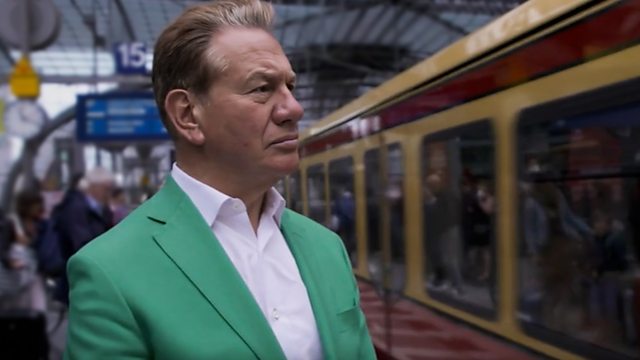
Berlin to Stuttgart
Michael Portillo embarks on a rail journey through Germany. In a vast stadium, Michael hears how new rail lines were constructed to transport crowds of spectators to the Nazi Olympic Games of 1936.
Michael Portillo embarks on a rail journey through Germany, steered by a Bradshaw’s Continental Railway Guide published in 1936. His unique window on Europe between the world wars takes him through a tumultuous period in German history, when the nation’s first democracy and its vibrant culture of art, design and decadence were swept away by fascism, nationalism and the increasing likelihood of war.
In a vast stadium, Michael hears how new rail lines were constructed to transport crowds of spectators to the Nazi Olympic Games of 1936. Michael learns how a planned boycott by the United States and other European nations failed and how the success of a black American athlete undermined the Nazi ideology of Aryan superiority.
At the Museum of Modern Art in Berlin’s Kreuzberg, Michael sees how a leading artist of the era, George Grosz, warned of the rise of fascism in a haunting self-portrait. Michael goes to the movies in Potsdam and discovers the success of the Babelsberg Studios, where directors such as Fritz Lang and stars such as Marlene Dietrich worked. He hears how production was taken over by the Nazis for propaganda.
In the Schöneberg district of the capital, Michael researches the decadent night scene of the 1920s, where sexual freedoms attracted gay and lesbian visitors from across the world. Michael sees how cabaret culture is being revived today - a burlesque performance is on the bill.
At the birthplace of German democracy in Weimar, Michael investigates the beginnings of Bauhaus design and visits the movement’s first building – a single-family house which went beyond a statement of style to present a vision of how people would live in the 20th century.
Travelling with author Julia Boyd to Nuremberg, Michael discovers that during the 1930s, despite the First World War and the Third Reich, Britons and Americans loved Germany and German culture. Michael hears how one Briton above all was welcomed by Hitler to Germany - the Duke of Windsor, former King Edward VIII.
In the medieval Bavarian city of Nuremberg, Michael visits the monumental buildings and parade grounds, which were the stage for vast Nazi rallies to publicise the regime around the world and arouse popular support at home. Michael finishes in Stuttgart, where an ambitious engineering project is under way, which will integrate the city into a high-speed train route connecting Paris with Bratislava.
Michael bags a ride in a high-performance Porsche to the manufacturer’s Stuttgart headquarters and discovers that in the 1930s, the founder designed an affordable car for mass production – the Beetle.
Last on
More episodes
Previous
Music Played
-
![]()
Rainman
Summer of Love (Girls Like Boys Mix)
-
![]()
Champagne Morales
Could It Be
Credits
| Role | Contributor |
|---|---|
| Presenter | Michael Portillo |
| Series Editor | Alison Kreps |
| Executive Producer | John Comerford |
| Director | Tom Richardson |
| Production Company | FremantleMedia UK |
Broadcasts
- Wed 19 Aug 2020 20:00
- Sat 22 Aug 2020 18:00������̳ Two except Northern Ireland & Northern Ireland HD
- Thu 3 Sep 2020 08:15
- Wed 20 Apr 2022 19:00
- Wed 13 Mar 2024 19:00
- Thu 14 Mar 2024 01:05
Steam Railways
A collection of programmes from the ������̳ archives on the beauty of steam locomotives.

